Презентация infectious process ok-2


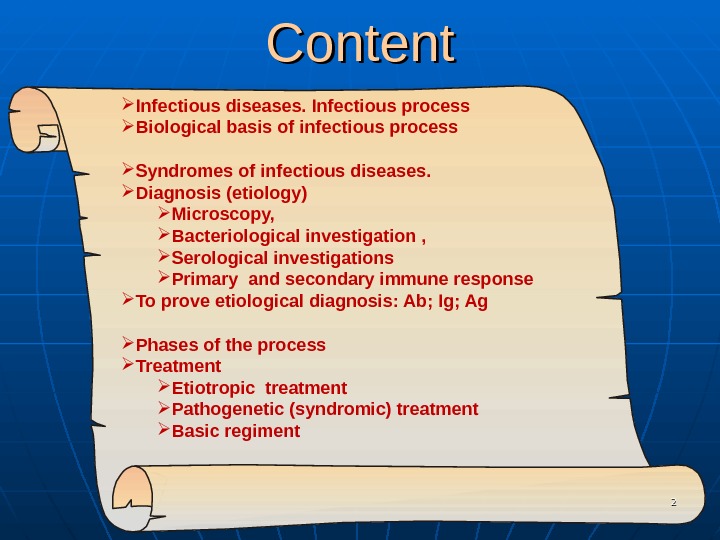
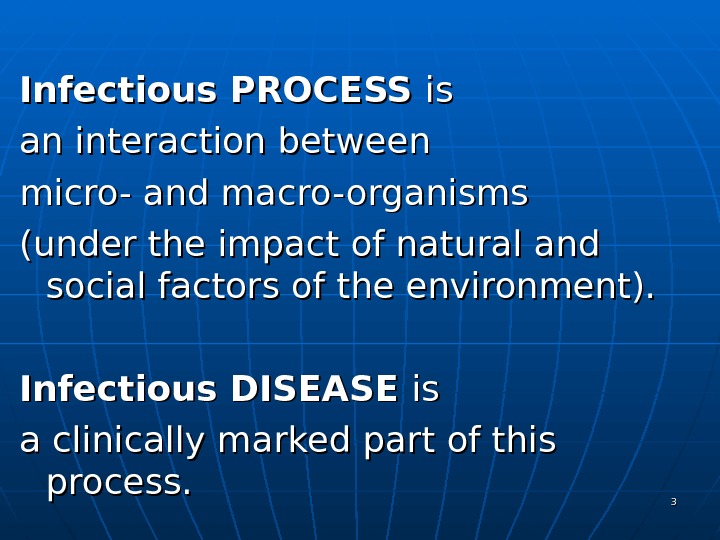




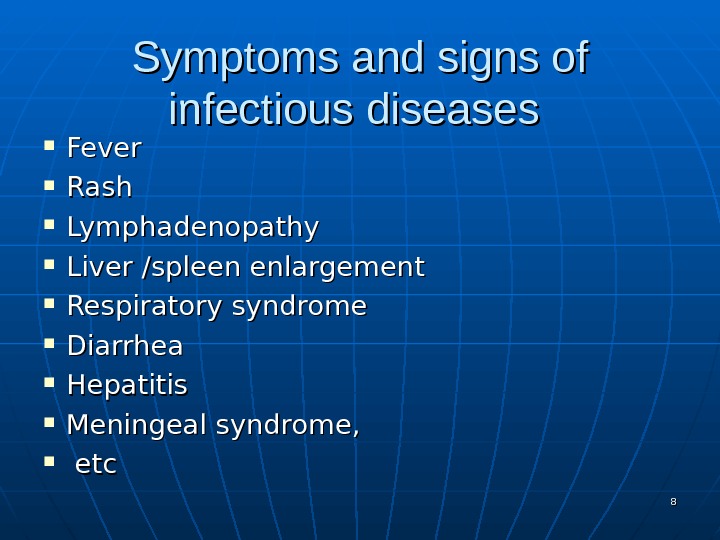



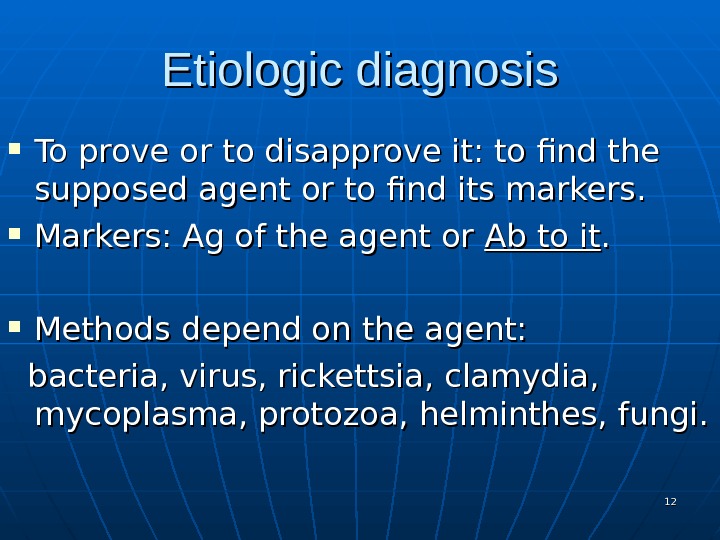




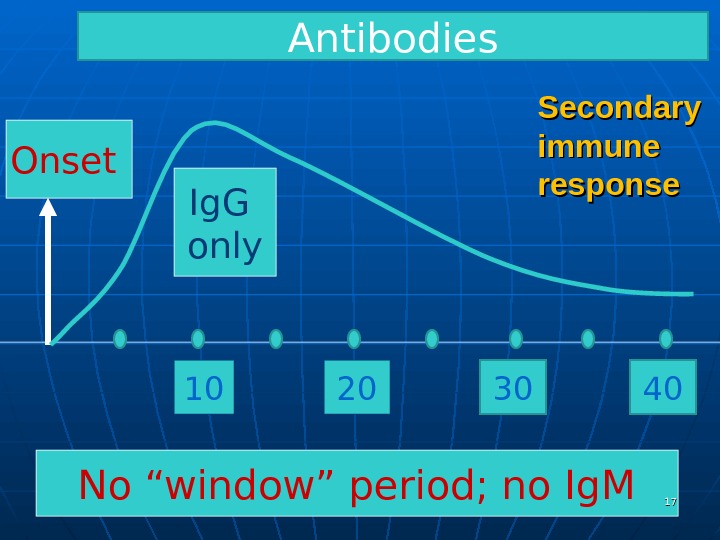













- Размер: 1.1 Mегабайта
- Количество слайдов: 30
Описание презентации Презентация infectious process ok-2 по слайдам
 II NFECTIOUS PROCESS Dr. Nossikova Y. V.
II NFECTIOUS PROCESS Dr. Nossikova Y. V.
 Content Infectious diseases. Infectious process Biological basis of infectious process Syndromes of infectious diseases. Diagnosis (etiology) Microscopy, Bacteriological investigation , Serological investigations Primary and secondary immune response To prove etiological diagnosis: Ab; Ig; Ag Phases of the process Treatment Etiotropic treatment Pathogenetic (syndromic) treatment Basic regiment
Content Infectious diseases. Infectious process Biological basis of infectious process Syndromes of infectious diseases. Diagnosis (etiology) Microscopy, Bacteriological investigation , Serological investigations Primary and secondary immune response To prove etiological diagnosis: Ab; Ig; Ag Phases of the process Treatment Etiotropic treatment Pathogenetic (syndromic) treatment Basic regiment
 Infectious PROCESS is is an interaction between micro- and macro-organisms (under the impact of natural and social factors of the environment). Infectious DISEASE is is a clinically marked part of this process.
Infectious PROCESS is is an interaction between micro- and macro-organisms (under the impact of natural and social factors of the environment). Infectious DISEASE is is a clinically marked part of this process.
 Infectious diseases There is an agent =>=> Contagious: can be transmitted to another macro-organism => possibility of an outbreak. Cyclic course (timing).
Infectious diseases There is an agent =>=> Contagious: can be transmitted to another macro-organism => possibility of an outbreak. Cyclic course (timing).
 Infectious process. got inf. Disease: Severe. Moderate. Mild. Sub-clinical. Carriage. incub relapse. Clinical recovery: sanitation or chronic formonset
Infectious process. got inf. Disease: Severe. Moderate. Mild. Sub-clinical. Carriage. incub relapse. Clinical recovery: sanitation or chronic formonset
 Biological basis of infectious process Agent’s factors : : pathogenic power; portal of entry of infection; dose Host’s factors: genetically determined: non-specific and specific resistance (HLA) acquired: nutrition, intoxications, ecologic factors, behavior patterns, vaccination, treatment.
Biological basis of infectious process Agent’s factors : : pathogenic power; portal of entry of infection; dose Host’s factors: genetically determined: non-specific and specific resistance (HLA) acquired: nutrition, intoxications, ecologic factors, behavior patterns, vaccination, treatment.
 Complications Specific: typical to the disease (perforation of ulcers of small intestine in typhoid fever patients) Non specific (sepsis of another origin due to prolonged presence of intravenous catheter).
Complications Specific: typical to the disease (perforation of ulcers of small intestine in typhoid fever patients) Non specific (sepsis of another origin due to prolonged presence of intravenous catheter).
 Symptoms and signs of infectious diseases Fever Rash Lymphadenopathy Liver /spleen enlargement Respiratory syndrome Diarrhea Hepatitis Meningeal syndrome, etcetc
Symptoms and signs of infectious diseases Fever Rash Lymphadenopathy Liver /spleen enlargement Respiratory syndrome Diarrhea Hepatitis Meningeal syndrome, etcetc

 Syndromes Congunctivitis, Tonsillitis, pharyngitis, stomatitis, … Pneumonia, bronchitis… Gastro-entero-colitis… Hepatitis… Kidney insufficiency (acute, chronic) Meningitis… DIC, etcetc
Syndromes Congunctivitis, Tonsillitis, pharyngitis, stomatitis, … Pneumonia, bronchitis… Gastro-entero-colitis… Hepatitis… Kidney insufficiency (acute, chronic) Meningitis… DIC, etcetc
 Diagnosis Anamnesis, symptoms and signs => syndromes. Prove the syndrome : : biochemical tests, ECG, X-ray, USI, etc. Anamnesis, association of syndromes => suggestion of etiology. Clinical etiologic diagnosis is always hypothetical => how to check it?
Diagnosis Anamnesis, symptoms and signs => syndromes. Prove the syndrome : : biochemical tests, ECG, X-ray, USI, etc. Anamnesis, association of syndromes => suggestion of etiology. Clinical etiologic diagnosis is always hypothetical => how to check it?
 Etiologic diagnosis To prove or to disapprove it: to find the supposed agent or to find its markers. Markers: Ag of the agent or Ab to it. . Methods depend on the agent: bacteria, virus, rickettsia, clamydia, mycoplasma, protozoa, helminthes, fungi.
Etiologic diagnosis To prove or to disapprove it: to find the supposed agent or to find its markers. Markers: Ag of the agent or Ab to it. . Methods depend on the agent: bacteria, virus, rickettsia, clamydia, mycoplasma, protozoa, helminthes, fungi.
 Microscopy Pluses: — fast — — the main method for protozoa, helminthes, fungi. Minuses: for bacterial infections in the most cases it is a tentative method. But sometimes can be very informative (N. meningitidis in CSF).
Microscopy Pluses: — fast — — the main method for protozoa, helminthes, fungi. Minuses: for bacterial infections in the most cases it is a tentative method. But sometimes can be very informative (N. meningitidis in CSF).
 Bacteriological investigation Pluses : accurate; sensitivity to antibiotics Minus : needs time (several days or more) Negative result does not always turn down a supposed diagnose: — defects of sample taking, transportation, media and lab technique; — recovery stage (spontaneous or due to correct treatment). Absence of correct suggestion! => media
Bacteriological investigation Pluses : accurate; sensitivity to antibiotics Minus : needs time (several days or more) Negative result does not always turn down a supposed diagnose: — defects of sample taking, transportation, media and lab technique; — recovery stage (spontaneous or due to correct treatment). Absence of correct suggestion! => media
 Serological investigations To detect antibodies to a suggested agent Antibodies – in serum (CSF). Pluses : simple; reliable; cheap; often – the only confirmation of a diagnosis. Minuses : : ““ window period”; investigation itself is fast, but results are always retrospective.
Serological investigations To detect antibodies to a suggested agent Antibodies – in serum (CSF). Pluses : simple; reliable; cheap; often – the only confirmation of a diagnosis. Minuses : : ““ window period”; investigation itself is fast, but results are always retrospective.
 Primary immune response. Onset 10 “ Window” period 20 Ig. G Ig. M Antibodies
Primary immune response. Onset 10 “ Window” period 20 Ig. G Ig. M Antibodies
 Secondary immune response. Onset 10 No “window” period; no Ig. M 20 Ig. G only Antibodies
Secondary immune response. Onset 10 No “window” period; no Ig. M 20 Ig. G only Antibodies
 To prove etiological diagnosis: Ab 4 times increase in titers of Ab to the agent (primary or secondary immune response): Samples should be taken twice in time! — — 1 -st time: the 1 -st week (zero is expected), — — 2 -nd time: in 2 weeks (maximum level). Diagnosis is late: after 2 -3 weeks; can be even later under effective treatment => — — the 3 d sample at week 5 -6 of the disease. The only test can be (+) due to previous disease, vaccination, poly-agglutination. “Min diagnostic level of Ab” is not reliable.
To prove etiological diagnosis: Ab 4 times increase in titers of Ab to the agent (primary or secondary immune response): Samples should be taken twice in time! — — 1 -st time: the 1 -st week (zero is expected), — — 2 -nd time: in 2 weeks (maximum level). Diagnosis is late: after 2 -3 weeks; can be even later under effective treatment => — — the 3 d sample at week 5 -6 of the disease. The only test can be (+) due to previous disease, vaccination, poly-agglutination. “Min diagnostic level of Ab” is not reliable.
 To prove etiological diagnosis: Ig Ig M (+) to the agent even once means the primary immune response. Ig M can be usually found since the 5 -th day of the disease up to the 4 -6 weeks. Rare Ig. M can persist much longer (HBV). Ig G(+) : >10 days of the disease (peak, recovery, chronic stage, previous disease or vaccination)–similar to Ab significance.
To prove etiological diagnosis: Ig Ig M (+) to the agent even once means the primary immune response. Ig M can be usually found since the 5 -th day of the disease up to the 4 -6 weeks. Rare Ig. M can persist much longer (HBV). Ig G(+) : >10 days of the disease (peak, recovery, chronic stage, previous disease or vaccination)–similar to Ab significance.
 To prove etiological diagnosis: Ag Ag can be found in any substrate. No “window” period => — Express-techniques to reveal the Ag (Ab with some additional mark to make immune complex visible): plague, etc. — PCR – to reveal DNA/RNA of the agent. In blood PCR(+): replication; PCR(-): no replication; sanitation -? => biopsy. Ag disappear in the process of sanitation in recovery stage => Ab.
To prove etiological diagnosis: Ag Ag can be found in any substrate. No “window” period => — Express-techniques to reveal the Ag (Ab with some additional mark to make immune complex visible): plague, etc. — PCR – to reveal DNA/RNA of the agent. In blood PCR(+): replication; PCR(-): no replication; sanitation -? => biopsy. Ag disappear in the process of sanitation in recovery stage => Ab.
 Phases of the process The end of incubation and the first part of the disease – presence of Ag; no Ab: the most contagious and dangerous part. Recovery with clearing from the agent: all Ag disappear, Ab become (+). Chronic form: presence of Ag, or Ag+Ab; sometimes – only Ab (anti-HBcor Ab). Life prognosis depends mostly on tissues functions (biochemical tests, ECG, etc).
Phases of the process The end of incubation and the first part of the disease – presence of Ag; no Ab: the most contagious and dangerous part. Recovery with clearing from the agent: all Ag disappear, Ab become (+). Chronic form: presence of Ag, or Ag+Ab; sometimes – only Ab (anti-HBcor Ab). Life prognosis depends mostly on tissues functions (biochemical tests, ECG, etc).
 Mixed infections, combination of different diseases Confirmation of the one disease does not allow us to exclude another one. To exclude (or confirm) a disease we should investigate for this disease. .
Mixed infections, combination of different diseases Confirmation of the one disease does not allow us to exclude another one. To exclude (or confirm) a disease we should investigate for this disease. .
 C B Dinf
C B Dinf
 Exact diagnosis: Prognosis spontaneous course (subclinical, mild, moderate, severe), under the treatment Treatment etiology, phase of the process, severity
Exact diagnosis: Prognosis spontaneous course (subclinical, mild, moderate, severe), under the treatment Treatment etiology, phase of the process, severity
 Infectious process. got inf. Disease: Severe. Moderate. Mild. Sub-clinical. Carriage. incub relapse. Clinical recovery: sanitation or chronic formonset
Infectious process. got inf. Disease: Severe. Moderate. Mild. Sub-clinical. Carriage. incub relapse. Clinical recovery: sanitation or chronic formonset
 Treatment Etiotropic – to affect the agent. Pathogenetic (syndromic)– to improve or to replace tissues functions. Symptomatic – to suppress symptoms.
Treatment Etiotropic – to affect the agent. Pathogenetic (syndromic)– to improve or to replace tissues functions. Symptomatic – to suppress symptoms.
 Etiotropic treatment Antibacterial, antiviral, antiprotozoal, etc. Result of therapy depends mostly on — — correct choice of spectrum and activity of preparations (if not correct: disease and treatment go own ways); — when the treatment is started (the first 1 -2 days => just stop the disease); — duration of the treatment.
Etiotropic treatment Antibacterial, antiviral, antiprotozoal, etc. Result of therapy depends mostly on — — correct choice of spectrum and activity of preparations (if not correct: disease and treatment go own ways); — when the treatment is started (the first 1 -2 days => just stop the disease); — duration of the treatment.
 Pathogenetic (syndromic) treatment Can be life-saving (rehydration in cholera, hemodialysis in HFRS, dehydration in brain edema, intubation in laryngeal diphtheria). Often it is the main part of the treatment: DS is too late to start etiotropic treatment (HAV, HF), or etiotropic treatment is not correct, etc.
Pathogenetic (syndromic) treatment Can be life-saving (rehydration in cholera, hemodialysis in HFRS, dehydration in brain edema, intubation in laryngeal diphtheria). Often it is the main part of the treatment: DS is too late to start etiotropic treatment (HAV, HF), or etiotropic treatment is not correct, etc.
 Basic regiment Bed rest Diet: in acute diseases – according to appetite; boiled and cultured milk foods can be used in any situation. Liquids. Clinical observation (behavior, t, pulse, BP, RR, diuresis, symptoms and signs). Symptomatic treatment — can be useful.
Basic regiment Bed rest Diet: in acute diseases – according to appetite; boiled and cultured milk foods can be used in any situation. Liquids. Clinical observation (behavior, t, pulse, BP, RR, diuresis, symptoms and signs). Symptomatic treatment — can be useful.


